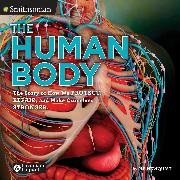Read more
The science and inventions that make us who we are . . . literally!Did you know the first blood transfusions were between people and lambs? Or that the first prosthetic hand with a hook was created so a French soldier could hold the reins of his horse in battle? Or that scientists recently grew a nose?
Invention & Impact, an exciting new series from PYRG-Smithsonian, introduces young readers to experiments, discoveries, and breakthroughs such as these, which have huge impacts on our world. Designed with exciting images from the Smithsonian's vast collections, each highly visual book in the series starts with a big idea and then explores that concept through specific objects that give kids the micro and meta picture on how inventions and ideas connect over time.
The debut book in the series looks at one of the most complex systems on planet Earth: the human body. From artificial eyeballs to aspirin to 3-D printed body parts, The Human Body profiles the objects that scientists and tinkerers throughout history have invented (or cobbled together) to protect, repair, or improve our physical selves. And there are plenty of fascinating stories behind these objects!
About the author
HP Newquist (www.newquistbooks.com) is the author of more than a dozen nonfiction books for children, including The Book of Blood, a National Science Teachers Association Outstanding Science Book of the Year and the critically acclaimed The Great Brain Book, an NSTA and Children’s Book Council Outstanding Science Book of the Year.
Summary
The science and inventions that make us who we are . . . literally!
Did you know the first blood transfusions were between people and lambs? Or that the first prosthetic hand with a hook was created so a French soldier could hold the reins of his horse in battle? Or that scientists recently grew a nose?
Invention & Impact, an exciting new series from PYRG-Smithsonian, introduces young readers to experiments, discoveries, and breakthroughs such as these, which have huge impacts on our world. Designed with exciting images from the Smithsonian's vast collections, each highly visual book in the series starts with a big idea and then explores that concept through specific objects that give kids the micro and meta picture on how inventions and ideas connect over time.
The debut book in the series looks at one of the most complex systems on planet Earth: the human body. From artificial eyeballs to aspirin to 3-D printed body parts, The Human Body profiles the objects that scientists and tinkerers throughout history have invented (or cobbled together) to protect, repair, or improve our physical selves. And there are plenty of fascinating stories behind these objects!
Additional text
Praise for The Human Body:
"The human body, for all of its amazing traits, is capable of breaking down, and this informative book covers both historical and modern innovations that help repair and strengthen it. . . the openpage design and ample full-color photos and historical diagrams will easily draw in middle-grade readers, especially those looking for a more macabre look at history and science." -Booklist
"An effective approach, one that follows developments in medical innovation across the centuries. . .Numerous photographs and historical illustrations of current and past medical devices-including the gruesome tools once used for surgery and tooth extraction-provide fascinating detail and context."-The Horn Book
Accolades for HP Newquist:
NSTA Outstanding Science Book of the Year, The Great Brain Book and The Book of Blood
CBC Oustanding Science Book of the Year, The Great Brain Book
ALA "Quick Pick," For Boys Only

